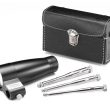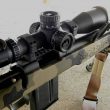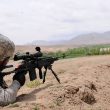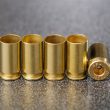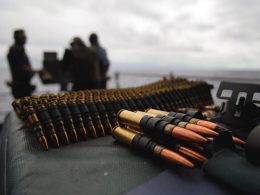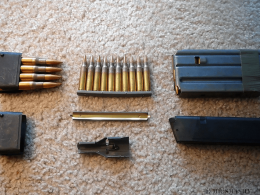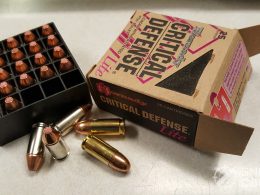Although the .223 Remington, .308 Winchester, and .300 Magnums are commonly used as sniper cartridges, they aren’t the most suitable. Consequently, the sniping community has been looking at the high velocity 6mm cartridge as a possible solution.
In 2003, Winchester introduced the .243 Winchester Super Short Magnum and this article compares its ballistic performance against that of the existing .223, .308 and .300 cartridges.
Limitations of Existing Cartridges
The existing cartridges have their use in personal and tactical arsenals, even though they present several inadequacies. Looking at the velocity of the .223 Remington, at 400m, its trajectory is relatively flat with repeatable hits at 600m. However, its’ performance deteriorates at longer ranges as it decelerates with reduced wounding potential. This is what motivated the military’s development of the 6.8mm cartridge. While it certainly was an improvement to the .223, it wasn’t the ultimate solution. The reason the .223 was initially used for sniping is because the AR-15s are chambered to allow for a semi-automatic rifle, it has little logistic and repair issues, minimal re-training for operation and maintenance and negligible recoil to reduce training and flinching.
The .308 Winchester is the most popular sniper cartridge and was used as the standard round for western service rifles for more than four decades due to its exceptional accuracy and slight blast and recoil. While this cartridge is set to stay in service indefinitely, it too comes with notable weaknesses. Firstly, let’s compare its trajectory with that of the other sniper cartridges. With a low initial velocity, it has the steepest exterior ballistic arc. Although snipers discovered how to counteract the trajectory, it didn’t solve the problem. The low velocity also makes this cartridge prone to wind effects. To mitigate these problems, the .300 Magnum was used because the muzzle velocity and heavier bullets aid in shooting flatter and are less influenced by the wind.
Snipers using the .300 cartridge only needed about 75% elevation adjustment and 50% windage compensation compared to the .308. This lets the snipers shoot longer ranges with better reliability and consistency than the .308. However, in saying this, the .300 doesn’t come without its issues such as having increased blast and recoil, which promotes flinching and less proclivity to train.
General Advantages of the .243 WSSM
In reviewing the .243 WSSM, two particular rounds were assessed for performance, the 95-grain Winchester Supreme Ballistic Silvertip factory cartridge and Berger’s 115-grain Very Low Drag boat tail hollow point. Both significantly surpass the performances of the .223, .308., and .300 cartridges, with one exception where the .300 bucks wind better than the 95gr SBST. The .243 WSSMs used with the 95- and 115-grain should perform better than the existing sniper cartridges with regards to trajectory, wind, and the lead required for movers. In summary, the .243 WSSM rounds shoot faster and flatter than a .300 with diminished recoil compared to the .308.
Winchester 95gr Supreme Ballistic Silvertip
For many years, the 95-grain SBST was loaded in .243 Winchester hunting rifles for hunting game animals like mule and white tail deer. Its terminal ballistic properties include rapid expansion and deep penetration that provides sharp accuracy, a high BC, and remarkable wounding potential.
The .243 WSSM is available in factory and custom bolt action rifles but the highlight of this caliber/cartridge combination is the Olympic Arms offering complete AR-15s and uppers in this caliber and being able to feed all Winchester’s factory ammunition like the 95-grain SBST (eight rounds of .243 WSSM fit in a 20rd .223 magazine). Snipers can then use a semi-automatic sniper rifle or bolt gun in .243 WSSM while being supported by their spotter using an AR in the same caliber. This is a substantial improvement in having a semi-automatic rifle that can shoot flatter than the .300 and has less recoil compared to the .308 AR-10/SR-25, mounted on an AR-15 lower.
Berger 115gr Very Low Drag
Berger’s 115-grain Very Low Drag boat tail hollow point bullet resolves the ability to buck wind when compared with the .300. The 95-grain SBST is however affected more by wind than the .300. The 115-grain has such little deflection that the windage figures are closer to the .338 Lapua than the .300.
Although the 115-grain VLD bullet is too long for the AR-15 magazines, .308 manufacturers like Armalite, Bushmaster, DS Arms, Springfield Armory, or DPMS should allow for modifying the .308 receiver to be able to contain the 115-grain bullet. The M14 and FAL magazines should be able to accept the long cartridge, resulting in minimal recoil.
Military snipers who have always used 175-grain or 190-grain bullets may think a 115-grain is too small but in challenging winds or UKD environments, the ballistics of the .243 WSSM / 115-grain VLD cartridge gives a hit where other configurations are likely to miss.
Conclusion
The combination of the .243 WSSM / 115-grain Very Low Drag is worthy of an in-depth analysis because the results show it to be more a far more effective option than the 6.8mm that’s currently being used by the military. The .243 WSSM used with the 95-grain SBST and the 115-grain could represent significant progress in ballistic performance for snipers. The tactical combination of the flat trajectory, low recoil, and ability to feed through AR rifles stands out as potential solutions.
| Cartridge | Ballistic | Muzzle Velocity | 100y | 200y | 300y | 400y | 500y | 600y | 700y | 800y | 900y | 1k y | Wind 400y | wind 1k y | Walk 400y | walk1k y |
| Coefficient | ||||||||||||||||
| .223 55gr SBST | 0.267 | 3200 | 0 | 1.31 | 3.47 | 6.24 | 9.69 | 13.99 | 19.36 | 26.08 | 34.35 | 44.25 | 5.22 | 19.13 | 8.1 | 12.9 |
| .223 69gr BTHP | .301 2800+ | 3000 | 0 | 1.6 | 4.07 | 7.15 | 10.89 | 15.4 | 20.88 | 27.51 | 35.49 | 44.89 | 4.51 | 15.3 | 8.5 | 12.8 |
| .305 2200-2800 | ||||||||||||||||
| .317 0-2200 | ||||||||||||||||
| .243 WSSM 95gr SBST | 0.4 | 3250 | 0 | 1.13 | 2.96 | 5.15 | 7.69 | 10.61 | 13.95 | 17.8 | 22.24 | 27.4 | 2.82 | 9.29 | 7.3 | 9.9 |
| .243 WSSM 115gr VLD | 0.597 | 3000 | 0 | 1.34 | 3.32 | 5.6 | 8.12 | 10.88 | 13.91 | 17.21 | 20.84 | 24.81 | 2.01 | 5.98 | 7.5 | 9.1 |
| 6.8mm SPC 115 gr MC | 0.325 | 2800 | 0 | 1.91 | 4.73 | 8.21 | 12.4 | 17.45 | 23.55 | 30.88 | 39.59 | 49.73 | 4.62 | 15.55 | 9 | 13.4 |
| .308 168gr BTHP | .447 2100+ | 2600 | 0 | 2.14 | 5.07 | 8.48 | 12.36 | 16.76 | 21.75 | 27.42 | 33.85 | 41.14 | 3.29 | 10.43 | 9.1 | 11.9 |
| .424 1600-2100 | ||||||||||||||||
| .405 0-1600 | ||||||||||||||||
| .300 mag 190gr BTHP | .533 2100+ | 2900 | 0 | 1.53 | 3.74 | 6.31 | 9.19 | 12.4 | 15.97 | 19.95 | 24.4 | 29.39 | 2.47 | 7.7 | 7.92 | 10 |
| .525 1600-2100 | ||||||||||||||||
| .515 0-1600 | ||||||||||||||||
| .338 300gr BTHP | .768 2300+ | 2800 | 0 | 1.59 | 3.8 | 6.29 | 8.98 | 11.89 | 15 | 18.33 | 21.91 | 25.75 | 1.68 | 4.8 | 7.9 | 9.1 |
| .760 1800-2300 | ||||||||||||||||
| .750 0-1800 |
Notes:
All values are in MOA. Wind values are for a 10mph cross wind at full value. The walker is moving at 4mph at full value.
All calculations performed by JBM Trajectory Calculation Page (http://www.mega.nu:8080/traj.html), and assume 55 degrees Fahrenheit at 1,000′ of altitude SBST ammunition is Winchester’s Supreme Ballistic Silvertip.
BTHP ammunition is Federal’s Matchking with Sierra bullets.
VLD ammunition is Berger’s Very Low Drag bullet.
MC ammunition is Remington’s Metal Case bullet.

